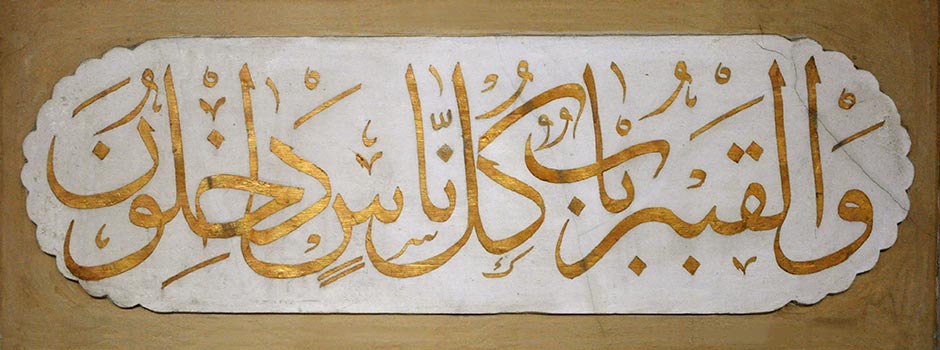
ART HISTORY Husein Rakim Islamovic, 19th Century Bosnian Calligrapher
Jun 10, 2017 Calligraphy
This article is a part of the project 'Promotion of the Ottoman Cultural Heritage of Bosnia and Turkey' which is organized by Monolit, Association for Promoting Islamic Arts and supported by the Republic of Turkey (YTB - T.C. BAŞBAKANLIK Yurtdışı Türkler ve Akraba Topluluklar Başkanlığı / Prime Ministry, Presidency for Turks Abroad and Related Communities).
Husein Rakim Islamovic was born in Sarajevo in 1839 and died in Anatolia in 1895. He gained his primary education at the Gazi Husrev Beg Madrasa in Sarajevo. He studied calligraphy in his hometown with the famous calligrapher Abdullah Ajnija Hasanagić and later he perfected aklam-i sitte in Istanbul, where he received four degrees (ijazah), two for thuluth and naskh from Sayyid Mohammed Ševki and Yahya Hilmi, and two for taliq style from Alija Hajdar, Hafid Melek Pasha, Sami H. Zekija and Muhammad Arif. These diplomas are kept in the museum collection of the Gazi Husrev Beg Library in Sarajevo.
Both diplomas for thuluth and naskh style are in the form of kit'a levha. They were penned on brown paper with a black ink (is műrekkep). All the text is placed in the shapes that follow the form of the text. The blank space around these shapes is gold-plated with a very shallow embossed dots (bejne'l-sutur). Text is separated by borders and floral decoration. Illumination of these decorative motifs is crafted in full colours and naturalistic, with spiral strips which are wrapped around the bouquet of flowers. On the border of both levhas are typical floral baroque motifs, illuminated in gold and white on a dark blue background. Illumination is probably done by a Turkish artist. Calligraphy on these diplomas represents an excellent example of high aesthetic level of perfected thuluth and naskh style.
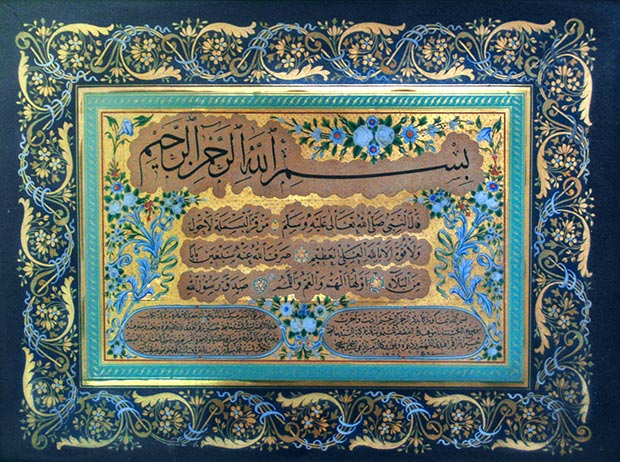 Husein Rakim Islamovic, Ijazah for thuluth and naskh style, The museum collection of the Gazi Husrev Beg's Library. Photo by Dr. Meliha Teparić
Husein Rakim Islamovic, Ijazah for thuluth and naskh style, The museum collection of the Gazi Husrev Beg's Library. Photo by Dr. Meliha Teparić
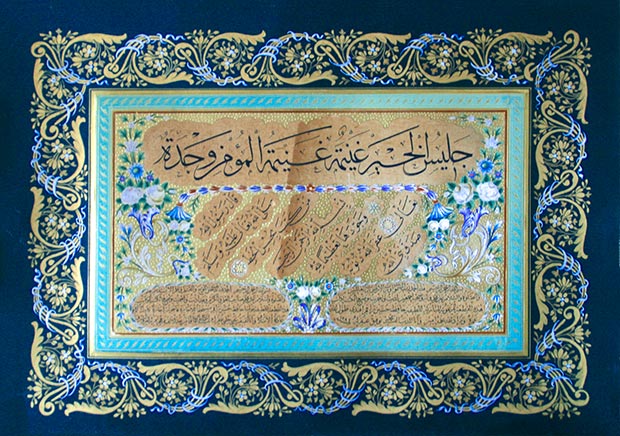 Husein Rakim Islamovic, Ijazah for thuluth and naskh style, The museum collection of the Gazi Husrev Beg's Library. Photo by Dr. Meliha Teparić
Husein Rakim Islamovic, Ijazah for thuluth and naskh style, The museum collection of the Gazi Husrev Beg's Library. Photo by Dr. Meliha Teparić
Two other calligraphic diploma, for nestaliq style, also in the form of kit'a levha, have the text written with black ink (is műrekkep) on a bright cream paper. Signature is in the lower left corner in taliq style, located at the bottom of the composition in an oval shape, flowing horizontally in three rows. Calligraphic text is written in a clear, precise and highly sophisticated proportions. Levha has minimal decoration, illuminated with gold. The text compositions are framed by borders and have wide margins of which the upper one is somewhat bigger.
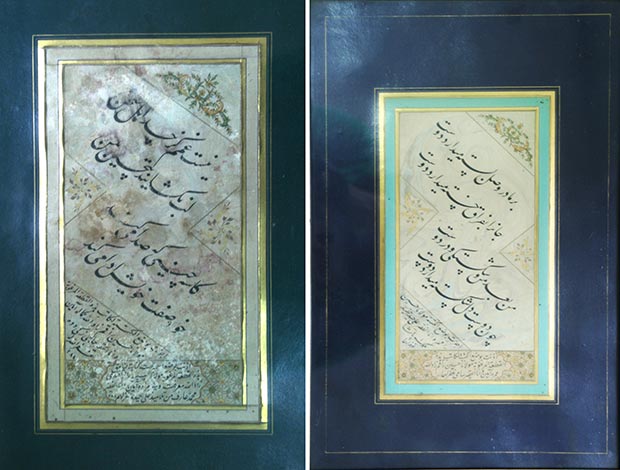 Husein Rakim Islamovic, diplomas for taliq style. The museum collection of the Gazi Husrev Beg's Library. Photo by Dr. Meliha Teparić
Husein Rakim Islamovic, diplomas for taliq style. The museum collection of the Gazi Husrev Beg's Library. Photo by Dr. Meliha Teparić
These four calligraphic diplomas are now the only preserved levhas by Islamovic and show full maturity of calligraphic compositions, confirming first-class artistic level of execution when it comes to proportions and composing letters, relations between positive and negative forms, the strokes, sharpness of the external lines of letters, etc.
Islamovic was also teaching calligraphy. In Sarajevo he held a private calligraphy school, that produced many acclaimed Bosnian calligraphers (hattat), among them Muhammad Behaudin Sikirić, Akif Hadžihuseinović Muvelat, Sulejman ÄŒuÄak, Mustafa ÄŒadordžija and Abdullah Ajni BuÅ¡atlić.
It seems that his capital calligraphy work was the large composition ensemble for the Gazi Husrev Beg Mosque in Sarajevo, in 1884-85. These calligraphic compositions were not preserved in the process of restoration of the Mosque in the early 20th century. The photos that document the process of removal during the restoration are now in possession of the Gazi Husrev Beg Waqf. Also, the Archives of Waqf Administration for Bosnia and Herzegovina had the samples of two paper sheets of common size, which were used by Islamovic to sketch his compositions. Their current location is unfortunately unknown. From this great calligraphic series only two circular compositions are preserved, in stucco above the entrance door of the Gazi Husrev Beg Mosque.
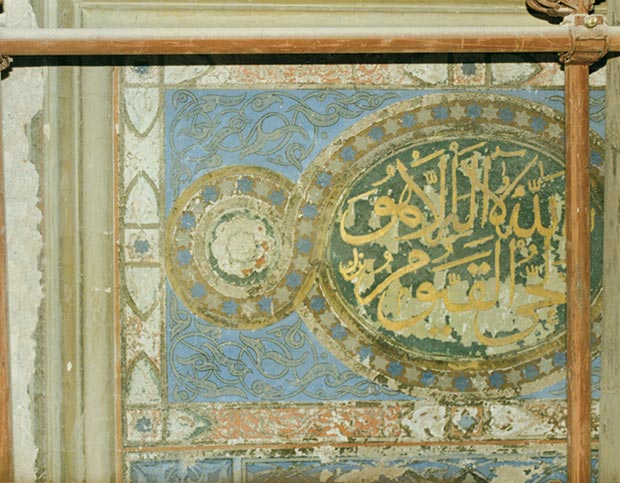 The calligraphic compositions by Husein Rakim Islamovic at the Gazi Husrev Beg Mosque in the early 20th century. Photo courtesy of the Gazi Husrev Beg Waqf
The calligraphic compositions by Husein Rakim Islamovic at the Gazi Husrev Beg Mosque in the early 20th century. Photo courtesy of the Gazi Husrev Beg Waqf
_IslamicArtsMagazine.jpg) Two circular calligraphic compositions by Husein Rakim Islamovic from the entrance door of the Gazi Husrev Beg Mosque. Photo © Islamic Arts Magazine
Two circular calligraphic compositions by Husein Rakim Islamovic from the entrance door of the Gazi Husrev Beg Mosque. Photo © Islamic Arts Magazine
Islamovic is also the author of two series of eight wall calligraphies in the Gazi Husrev Beg Turbe (mausoleum). Circular calligraphies, located beneath the windows, are created in jali thuluth style, with golden letters on a dark background. The second series of calligraphy in the same mausoleum, are placed on the walls slightly lower than the circular calligraphy. They are also written in jali thuluth style, composed in one line, in the rectangular shapes which at their ends have decorative semicircular endings. Calligraphy is composed with golden letters on a white background. The calligraphic composition in the Gazi Husrev Beg Turbe are well preserved and restored, and represent the only remaining example of wall calligraphy by Islamovic. The letters are beautifully and harmoniously composed by the rules and proportions of thuluth style.
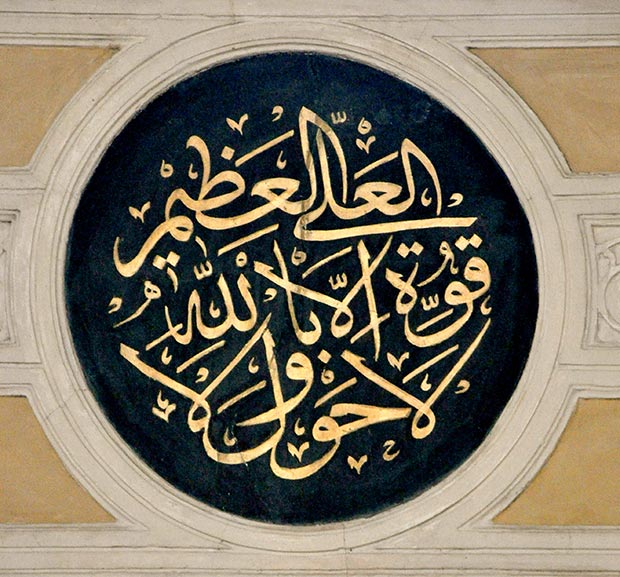 Circular calligraphic composition by Husein Rakim Islamovic from the Gazi Husrev Beg Turbe (mausoleum). Photo by Damir Tatlic
Circular calligraphic composition by Husein Rakim Islamovic from the Gazi Husrev Beg Turbe (mausoleum). Photo by Damir Tatlic
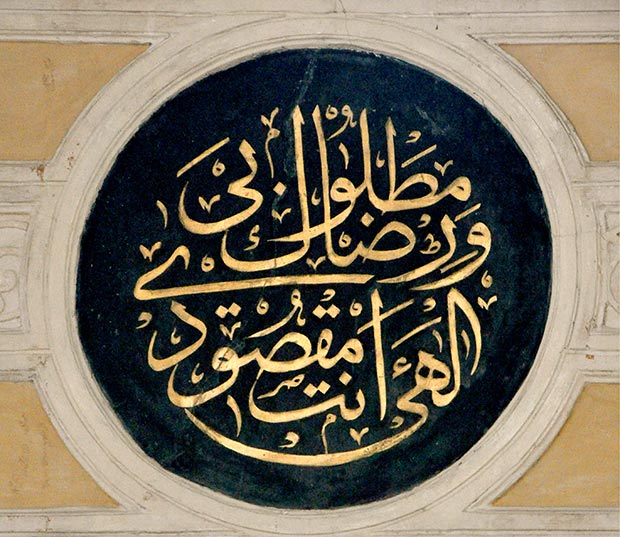 Circular calligraphic composition by Husein Rakim Islamovic from the Gazi Husrev Beg Turbe (mausoleum). Photo by Damir Tatlic
Circular calligraphic composition by Husein Rakim Islamovic from the Gazi Husrev Beg Turbe (mausoleum). Photo by Damir Tatlic
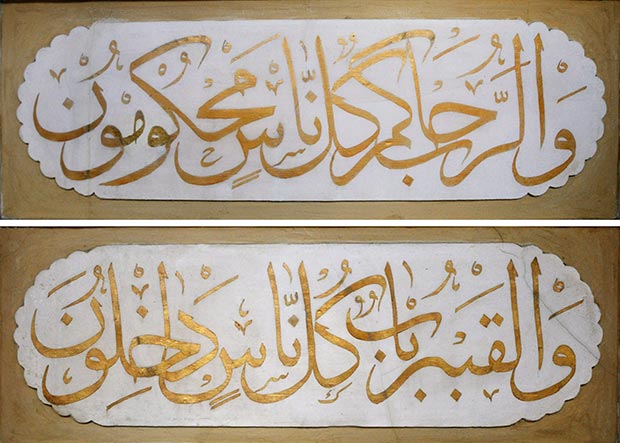 Single line calligraphic compositions by Husein Rakim Islamovic from the Gazi Husrev Beg Turbe (mausoleum). Photo by Damir Tatlic
Single line calligraphic compositions by Husein Rakim Islamovic from the Gazi Husrev Beg Turbe (mausoleum). Photo by Damir Tatlic
Two tombstones carry inscriptions created by Islamovic, tombstone of Salih Sidik Muvekit (Mehmed Mujezinovic, Islamic Epigraphy in Bosnia and Herzegovina I, Sarajevo, Sarajevo Publishing, 1998, 500) and the tombstone of Mustajbeg Dženitić (Mehmed Mujezinovic, Islamic Epigraphy I, 189).
Husein Rakim Islamovic excelled in naskh, thuluth and taliq style but most of his known works was created in jali thuluth, and we can conclude that it was his favourite style. He was very fruitful and successful 19th century Bosnian calligrapher.
Comments
Add a comment